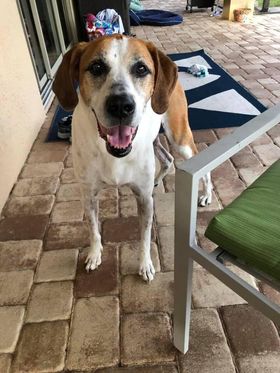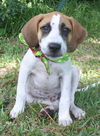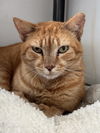
| My Rescue |
| Login to Remember your Favorite Animals and Breeds! |
Vir (Apollo) the Hound's brother, Londo the Bloodhound Puppy (adopted) can also be seen on our website.
Vir (Apollo) the Hound's brother, Lennier the Bloodhound Puppy (adopted) can also be seen on our website.
Vir (Apollo) the Hound's brother, Sheridan the Bloodhound Puppy (adopted) can also be seen on our website.
Vir (Apollo) the Hound's sister, Heather the Bloodhound Puppy (adopted) can also be seen on our website.
Vir (Apollo) the Hound's sister, Lemonade the Bloodhound Puppy (adopted) can also be seen on our website.
Vir (Apollo) the Hound's brother, Sinclair the Bloodhound Puppy (adopted) can also be seen on our website.
Vir is now Apollo, and he came back to us recently. We haven't seen him since he was a little roly-poly puppy, and the first thing that struck us was how TALL he is. He bays like a beagle or a bloodhound, but he's got the long legs of a greyhound. He has a very good temperment and plays well with other dogs. Every time we see him, his tail is wagging. We think maybe a home with a nice big yard would be great for him, or an owner who can take him on long walks--maybe even a run, if Apollo is up for it!
Leash Manners - Walks well on leash.
Crate/House Training - House trained - no accidents. Apollo is crate trained and is fed in his crate.
Socialization – He enjoys running in the yard with my dog. He enjoys tossing toys around and being near my dog inside. He is friendly with people and loves being petted. He will let you know if you haven't petted him enough.
Energy Level and Exercise – Moderate energy – enjoys the freedom of the yard and motivates my dogs to chase and play with him. He plays outside several times throughout the day. He enjoys toys and playing with his foster sister. He is calm/alert inside.
Daily Structure and Schedule – get up 6:30 -7 out in yard for 30 minutes. Eat breakfast in kennel. 30 minutes of quiet time after breakfast. Let them back out in to yard or den with me. 8:30 back in Kennel while I get ready for work (Workdays). some workdays he gets to go to work with me, other days he has to stay home. Dinner time is around 6:30 or 7 and he won't let you forget! After dinner 30 more minutes of quiet time and then he is free to roam the house, play with his sister, or sit with me. Bed time is 10- 10:30 which we go out one last time before bed. He sleeps in the bedroom with me. and he sleeps through the night.
Confidence Level – Friendly and confident with people. He is great with my dog and has made a few friends at work. Enjoys car rides. His tail is almost always wagging.
Obedience Training – He has learned/knows "sit","come" "House" and "no" He makes good eye contact and seems to want to please, so he should be easy to train.
Personality Quirks – I haven't seen any "quirks". Apollo is a really good dog with lots of love to give and recieve
Ideal Home - Would love an active home with a single person, a couple or a family. He would enjoy a fenced yard and someone who would enjoy walking and playing with him. He would enjoys my dog but seems to want my attention so I think he will be happy being an only dog if his owner enjoys spending time with him. He is playful and gentle and will bond quickly to a caring person who has time for him. He will make a loyal companion or a great family pet
Other Pictures of Vir (Apollo) the Hound (click to see larger version):
 19.7k |
 23.5k |
 24.9k |
 49.8k |
 40.8k |
 16.1k |
 52.9k |
 161.5k |
Copyright © Pet Rescue by Judy





